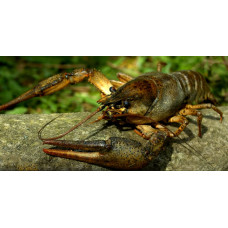River crayfish are two families of the decinate crayfish family (Reptantia: Astacidae and Parastacidae). Body length is usually 6-30 cm, rarely up to 80 cm. They inhabit mainly water bodies of the temperate zone. In addition to rivers and streams, may inhabit cave water bodies. They serve as indicators of water pollution. River crayfish are the objects of fishing and breeding.
The body is divided into a shield-covered (carapax) cephalothorax and a flatter, elongated abdomen ending in a caudal fin. For movement are 5 pairs of pectoral legs, at the bases of which are located gills. Abruptly bending the abdomen and waving the tail fan, the crayfish can quickly swim backwards. Sensory organs are antennae and compound eyes located on the stalks. The mouth of crayfish is surrounded by oral appendages - jaws and nogochelyusty. Food caught in the stomach, is ground there by special plates and enters the intestine. Undigested remains are excreted through the anus.
River crayfish are separate-sexed, with internal fertilization. Females lay eggs (60-200 eggs) and attach them to their abdominal legs. Approximately 6 months later, in spring, young crayfish appear, which are first kept on the body of the mother, several times molt and only a month after hatching go to independent life. During the 1st year of life young crayfish molt up to 5 times. Later they continue to molt, and by the 5th year the number of molts is reduced to two (in spring and fall). During the molting period (ca. 10 days), crayfish hide in shelters until the shell hardens. They live up to 20-30 years.
River crayfish live in fresh water bodies with clean water and are sensitive to pollution. During the day they hide under rocks, roots, snags, and burrows, and at night they come out in search of food. They eat mollusks, small crustaceans, plants, insect larvae and carrion.
River crayfish
Tags: river crayfish



